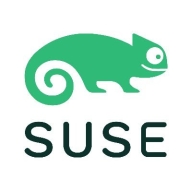


BMC TrueSight Server Automation and SUSE Manager are powerful tools for server automation and management, each with unique strengths according to user reviews. Users generally prefer the pricing and support of BMC TrueSight Server Automation, but SUSE Manager's features and overall value make it a superior choice for many users.
Features: BMC TrueSight Server Automation is praised for its extensive automation capabilities, granular access controls, and robust reporting features. SUSE Manager is noted for its integrated systems management, support for multiple Linux distributions, and efficient patch management. While both products offer valuable features, SUSE Manager's versatility gives it an edge.
Room for Improvement: User reviews indicate that BMC TrueSight Server Automation could benefit from a simpler learning curve, enhanced integrations with third-party tools, and improved usability. SUSE Manager could improve in scalability, advanced reporting functionalities, and user interface design.
Ease of Deployment and Customer Service: BMC TrueSight Server Automation users report a straightforward deployment model but face challenges with ongoing management and complex configurations. SUSE Manager is praised for its intuitive setup but has mixed reviews on the complexity of advanced deployments. In terms of customer service, BMC is recognized for its responsive support team, while SUSE Manager receives positive feedback for its comprehensive documentation and community support.
Pricing and ROI: BMC TrueSight Server Automation is often viewed as offering good value despite a higher upfront cost, with a clear ROI achieved through its extensive automation features. SUSE Manager is appreciated for its cost-effectiveness and strong ROI, especially for organizations heavily invested in open-source solutions. While BMC TrueSight Server Automation is seen as a premium product, SUSE Manager is favored for its affordability and value proposition.
Everything we've gained from it makes my job easier day after day, and I see value in it as an engineer.
Microsoft Intune not only saves costs by reducing the number of personnel needed but also offers a comprehensive solution for managing laptops, applications, security, individual access, and enrollment.
Importantly, when someone leaves the company, it helps protect document access on their devices.
When a support ticket is submitted, it directly reaches someone with Intune support expertise.
When I contacted Microsoft, they had the same expertise, if not more, which is phenomenal because I felt heard and my problem was solved.
Sometimes, the support provided is excellent, and the representative is knowledgeable, while other times, the service needs improvement.
Generally, the support is good, but there are instances where the support team seems disinterested in solving complex problems.
The scalability of Microsoft Intune is ten out of ten.
Ideally, we want to automatically segregate devices based on user properties like primary use, but currently, dynamic groups seem limited to device properties.
It supports organizations with 200 endpoints and those with more than 15,000 endpoints.
We have not experienced downtime, bugs, or glitches.
It appears Microsoft Intune undergoes changes without informing customers.
Microsoft Intune has been very stable.
The stability of SUSE Manager is fine.
Features like unlocking devices sometimes fail, and the support offered for other operating systems is insufficient.
There are communication issues, so you might start working with a feature without knowing if it will be deprecated six months from now.
Many third-party companies offer single-pane-of-glass reporting that shows you what your update environment looks like, how your patch is doing, application status, etc., but Intune's reporting is not intuitive.
A better description of the initial setup process could enhance user experience.
Features that can be helpful in disaster recovery.
From an integration perspective, it is difficult to integrate with Jira or any ticketing tool, which is challenging.
Introductory professional services, like a fast-track service, were included with our E5 membership, and there have been no additional costs.
The Intune suite and add-ons, such as batch management and remote help, are costly.
It costs approximately forty euros per user per month.
Intune excels in configuration and compliance management for Windows 10, ensuring devices receive timely updates and adhere to organizational standards.
Dynamic groups allow us to set conditions for automatic membership, eliminating the need for user intervention or manual review and ensuring a seamless workflow.
Windows Autopatch is the most valuable because it removes the burden of patch management.
The overall role of BMC TrueSight Server Automation in managing configuration drift brings return on investment through its automation, which helps save me the time and effort of my operations team.
It supports more than six or seven Linux flavors, and when compared to other tools such as Satellite, which only supports the Red Hat operating system, SUSE Manager supports Red Hat, Ubuntu, Debian, and some other Linux operating systems for patch management.
SUSE Manager is valuable for managing systems, patching, and utilizing SaltStack connectivity for various installations and other routines.
| Product | Market Share (%) |
|---|---|
| Microsoft Intune | 9.4% |
| SUSE Manager | 3.3% |
| BMC TrueSight Server Automation | 3.1% |
| Other | 84.2% |



| Company Size | Count |
|---|---|
| Small Business | 116 |
| Midsize Enterprise | 46 |
| Large Enterprise | 152 |
| Company Size | Count |
|---|---|
| Small Business | 2 |
| Midsize Enterprise | 5 |
| Large Enterprise | 15 |
| Company Size | Count |
|---|---|
| Small Business | 6 |
| Midsize Enterprise | 1 |
| Large Enterprise | 2 |
Microsoft Intune provides centralized management of mobile devices and applications, ensuring security, compliance, and productivity through integration with Microsoft services like Microsoft 365 and Azure Active Directory.
Organizations use Intune for managing mobile devices and applications, enhancing security and compliance across platforms. With features like single sign-on, conditional access, and zero-touch deployment via Autopilot, it facilitates efficient operations. Intune's scalability, easy enrollment, and capabilities such as remote wipe support diverse device management, offering robust data protection and efficient operation. Despite its features, improvement areas include reporting, compatibility with non-Microsoft devices, and better support for macOS and Linux devices.
What are the key features of Microsoft Intune?
What benefits should users look for in reviews?
In industries such as finance, healthcare, and education, Microsoft Intune is implemented to ensure secure and compliant device management. Companies leverage its capabilities to deploy security policies and manage both corporate-owned and BYOD environments, facilitating a unified approach to data protection and compliance.
BladeLogic Server Automation allows you to quickly and securely provision, configure, patch, and maintain physical, virtual, and cloud servers.
· Threat remediation: Combine with BMC SecOps Response Service to link vulnerabilities to identified patches and create a remediation plan
· Compliance: Integrates role-based access control, pre-configured policies for CIS, DISA, HIPAA, PCI, SOX, NIST, and SCAP, documentation, and remediation
· Provisioning: Supports unattended installs and image-based, script-based, or template-based provisioning
· Configuration: Consistently manage change and configuration activities across a broad range of server environments with one tool
· Reporting: Assess change impact or complete an audit using multiple dashboard views
· Patching: Supports and follows maintenance window guidelines to ensure timely delivery of patches
SUSE Manager was designed to help your enterprise DevOps and IT Operations teams reduce complexity and regain control of your IT assets with a single tool to manage Linux systems across a variety of hardware architectures, hypervisors as well as container, IoT and cloud platforms. It automates Linux server and IoT device provisioning, patching and configuration for faster, consistent and repeatable server deployment helping to optimize operations and reduce costs. And with automated monitoring, tracking, auditing and reporting of your systems, VMs, and containers across your development, test and production environments, you can ensure compliance with internal security policies and external regulations.
We monitor all Configuration Management reviews to prevent fraudulent reviews and keep review quality high. We do not post reviews by company employees or direct competitors. We validate each review for authenticity via cross-reference with LinkedIn, and personal follow-up with the reviewer when necessary.